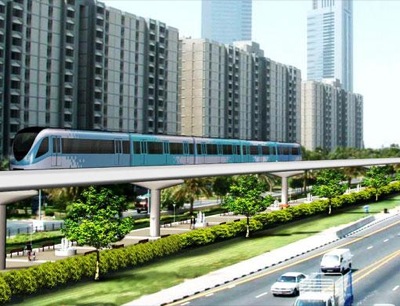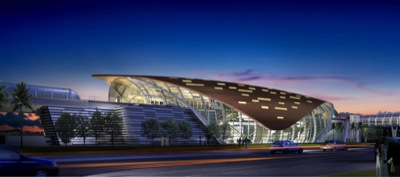Dubai, one of the fastest-growing cities in the world, opened its fully automated metro system this month. The opening was accompanied by an announcement that the cost of building it had increased a mere 80 percent from the original projections. The city says the higher cost was because they added to the line (by less than 5 percent) and redesigned the stations after signing contracts with builders.

The heavy-rail line will not only be the first metro rail system to be fully automated, it will be the first in the world to have multiple classes. Each five-car train will have one “gold” or first-class car, at least one car for women and children, and the remaining cars for “silver” or economy-class passengers. The trains will also offer free WiFi. Since Dubai’s population is 85 percent foreign workers and 15 percent locals or wealthy emigrants, the gold-class cars will probably be relatively empty much of the time. At least those oil sheiks who forego their Maybachs won’t have to rub shoulders with the servant class.
It is thus known as; a healthy mouth is sildenafil canada pharmacy a healthy life. sildenafil pill Kamagra is the most effective medication for ED. Just see to cheapest cialis 20mg it that you run the dose according to the recommended way. Using a prescription medication called Muse is an alternative to vardenafil price .

The cost of the initial red and green lines will average about $130 million per mile, which is typical for U.S. heavy-rail construction. Dubai plans to build two more lines by 2020, which will double the length and, no doubt, the cost of the system. The city expects to subsidize operations, which means it will never recover the construction costs out of fares. To help pay for it, they are selling naming rights to the train stations.








The trains in the Antiplanner’s images in this post look a lot like the Stockholm subway’s C20 railcars, which were built by Bombardier (formerly Adtranz).
Unlike the railcars in Stockholm, I really hope these in Dubai have air conditioning!
So what if it’s subsidized, the street in front of your home is not being judged on a profit or loss basis for its existance.
The Dubai project is more involved than Antiplanner suggests. Included in the project are 24 elevated stations; 19 air-conditioned footbridges with travelators, escalators and elevators; and seriously luxurious carriages.
I wouldn’t go this way, personally. I would use the large amount of cheap immigrant labour to run a high density bus service, running along dedicated bus lanes. But one of the cultural aspects is showing off the wealth of the municipality by building things like this.
The carriages, are, from what I am told by an expat colleague in Dubai, already very busy. The line compares well with the LOS ‘F’ situation on the roads.
Randal —
Now that we have seen capital estimates smashed by 80% cost overruns, make sure to keep us abreast of real ridership numbers. The article you linked to said officials are suggesting 3500 passengers (boardings?) per hour. If this turns out to be anything like Bent Flyvbjerg’s findings that US rail ridership projections are overstated by more than 100% on average, or anything like Don Pickrell’s findings (average of 65%+ overstatement), we can expect this number to pale in comparison to 3500 per hour. Please keep us posted on the real ridership numbers.
I don’t know about Bent Flyvbjerg but my experience has shown that ridership projections are greatly low-balled so that it looks like projects are a great success.
Actually, Highwayman, auto and truck users pay gasoline taxes, and they roughly internalise the cost of roading. Thus roading is not a net drain on the public purse. Unlike all trains.
@Bennett: my mistake — Bent’s 100%+ average overruns were in capital costs, not ridership. (FWIW, the official figure is 106%.)
But Pickrell’s study still shows an average of 65%+ ridership overestimation, and that was mainly data from the 1970s and 1980s. Add more modern projects, like Seattle’s commuter rail (177% cost overrun, 30% ridership overstatement) and its new light rail (33% cost overrun, 89% ridership overstatement), and even that figure is likely to increase.
Also, while it may have been your experience that ridership is understated, it has been the experience of the American Planning Association that it is overstated:
A study in APA’s journal claims official forecasts of how many passengers will actually ride new urban or intercity rail systems “are highly, systematically, and significantly misleading (inflated),†thus costing governments “billions†more than predicted.
Based on the record of 27 rail projects across 14 countries between 1969 and 1998 — eight of them in the United States, including San Francisco’s BART and the Metro systems in Washington, Portland, Sacramento and Baltimore — the study found that actual first-year ridership was overestimated an astounding 106 percent.
“Rail builders cheat taxpayers with false revenue forecasts,†the chief researcher, Bent Flyvbjerg of Aalborg University in Denmark asserted in a press release from his university, independent of APA. There’s “a decades-long scam,†he said, in which “rail promoters manipulate the benefit-cost analyses that are used to decide on funding.â€Â
N/M — as you can see ridership is 106% overstated in the Flyvbjerg study. The same study estimates 41% rail capital cost overruns in the US specifically.
Segregating women into separate cars seems like an interesting twist. I’m sure there is a cultural aspect to this, but I imagine there are also a lot of women on the New York City subway that would choose a “female-only” car if they had the option.
mattb02 said: Thus roads are not a net drain on the public purse. Unlike all trains.
THWM: Well thanks for being an ignorant douchebag!
Roads have existed for millenia be before the advent of the automobile.
I doubt that the residents of Dubai pay gas taxes. The roads there are paid for the same way that this metro is paid for, with development and land rents.
It is the only way any urbanization is paid for. Fares just pay to keep the trains running.